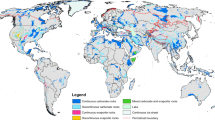Abstract
Methodological problems of climatic reconstruction for different periods of Holocene are discussed on the basis of a multiple group biological analysis on peat-sapropel sediments. The possibility of biological analysis is exemplified by the paleoclimatic reconstruction for Carpathian and Altai Mountain ranges. For the “Skolevsky Beskidy” national park of Carpaty the paleoclimatic scenarios have been drown up aiming at the more precise definition of climatic conditions for the period of mass mountain slope terracing. The stability of terrace systems of various designs in the current climatic conditions has been assessed. It is shown that during periods of humid climate the terraces, whose designs have been focused on drainage, were built. In periods of dry and warm climate the terrace systems capable of accumulating water were built. Both these types of terrace systems are destroyed in nowadays. Only those terrace systems are stable which were adjusted by their builders to contrast variations of precipitation.
For Western Altais the paleoclimatic scenario has been done to forecast the safety of the Bronze Age kurgans (burial earth mounds) with permafrost inside the construction. In the Altay region during the Holocene it has revealed two periods of sharp cooling, the peaks of which occurred in the intervals 4500–4300 and 2500–2300 years ago, and two periods of pronounced climatic drying 4900–4700 and 130–70 years ago. Depletion of the algae composition in the layer corresponding to the last period of drying climate indicates a very sharp change in the parameters of moisture and turning the lake into a dry swamp. Periods of cold weather may have contributed to the formation of special ritual traditions of the Sakan tribes that require the frozen ground to bury the dead. The later climate fluctuations identified have not affected the safety of permafrost in burial mounds constructed in the V–III cc BC.
Similar content being viewed by others
References
Alexandrovskiy AL, Alexandrovskaya EI (2005) Soil evolution and geographical environment. Nauka Press, Moscow, pp 223 (In Russian)
Bajlagasov LV (2003) To the characteristic of lakes of Multy basin (Katunsky biospheric reserve). In: Baryshnikov G Ya (ed.) Geography and wildlife management of Siberia. Collected Papers, v.6. Altay University press, Barnaul, pp 185–202 (In Russian)
Galakhov VP, Mukhametov RM (1999) Glaciers of Altai. Nauka Press, Novosibirsk, pp 136 (In Russian)
Gerasimenko NP (1997) Environment of human habitation in the southeast of Ukraine in the late glacial epoch and in the Holocene. Archaeological Anthology 6: 3–64
Kats NYa (1941) Swamps and peat swamps. Allowance for Universities. Uchpedgiz Press, Moscow, pp 400 (In Russian)
Khotinsky NA (1977) Holocene of the Northern Eurasia. Nauka Press, Moscow, p 198(In Russian)
Korde NV (1960) Biostratification and typology of Russian sapropels. Academy of USSR Press, Moscow, pp 220 (In Russian)
Marsadolov LS, Zajtseva GI (1999) Correlation of radiocarbon and archaeological datings for small and average kurgans of Sajano-Altai in the 1st millenium BC. In: Kirjushin YuF and Tishkin AA (eds.) Results of studying of the Scythian epoch of Altai and adjacent territories. Altay University press, Barnaul, pp 108–115 (In Russian)
Samashev ZS, Zhumabekova GS, Sungataj S (1999) New researchs on the burial ground Berel in the East Kazakhstan. In: Kirjushin YuF and Tishkin AA (eds.) Results of studying of the Scythian epoch of Altai and adjacent territories. Altay University Press, Barnaul, pp 159–165 (In Russian)
Skripnikova MI (2007) Soil cover structure on anthropogenic terraces in mountains of Eurasia. In: Aparin BF (ed.) Proceed. Conference “The spatial and temporal organisation of soil cover: theoretical and applied aspects”, St.-Petersburg University Press, St.-Petersburg, pp 506–508 (in Russian)
Skripnikova MI, Kit MG, Radzii VF, Sveshnikova VA (2001) Ancient anthropogenic terrace complexes in the north Caucasus and Carpathians as the model of sustainable highly productive agroecosystems. In: Rubio J, Morgan RPC, Asins S, Andreu V (eds.) Proceedings of the Third International Congress of the European Society for Soil Conservation, Spain “Man and soil at the third millennium”, 1:821–832
Skripnikova M, Shpakivska I, Mariskevich O, Puka E (2004) Anthropogenic terracing agroecosystems of mountain landscapes in the Caucasus, Karpaty, Crimea and Altai. In: Physical Geography and Geomorphology. Collected papers, V. 46, N1, Obriy Press, Kiev, pp 137–147 (In Ukrainian)
Skripnikova MI, Uspenskaya ON (2003) Paleoclimatic reconstruction on the basis of the interfaced analysis of soil profiles, peat sediments and sapropelic thicknesses. In: Proceedings of XVI Ural Archaeological Meeting, Permsky University Press, Perm’, pp 19–22 (In Russian)
Skripnikova MI, Uspenskaya ON (2006) Applied aspects of studying the Holocene evolution of soil vegetation complexes in the middle Amur Region, the Far East of Russia. In: Proceedings of 18th World Congress of Soil Science Symposium “The Role of Soil Morphology in its Assessment” Abs.ID: 19493, Philadelphia, USA. 12–17 July (electronic publication)
Tjuremnov SN (1956) Age of sapropelic sediments in the middle region of the European part of the USSR. In: Transactions of the lab of sapropelic sediments IV: 135–142 (In Russian)
Uspenskaya ON (1986) Other algae. In: General rules of occurrence and development of lakes. Methods of studying of lake history (Series: Treshnikov AF (ed.) History of lakes in USSR). Nauka Press, Leningrad. pp 146–151 (In Russian)
Uspenskaya ON (2003) Quality of organic soils for agricultural use of cut over peatlands in Russia. In: Organic soils and peat materials for sustainable agriculture. CRC-Press, New-York, pp 175–1862
Vorontsov D, Puka E, Kozlovsky V (2004) Plant cover of oligotrophic sphagnous Zhuravlinoje swamp in Skolevsky Beskidy and its dynamic trends. Bulletin of Lvov National University, series Biology 37:114–124 (In Ukrainian)
Author information
Authors and Affiliations
Corresponding author
Rights and permissions
About this article
Cite this article
Skrypnikova, M., Uspenskaya, O. & Khokhlova, O. Paleoclimate study of mountain ecosystems by multiple group biological analysis. J. Mt. Sci. 8, 24–36 (2011). https://doi.org/10.1007/s11629-011-1033-y
Received:
Accepted:
Published:
Issue Date:
DOI: https://doi.org/10.1007/s11629-011-1033-y




